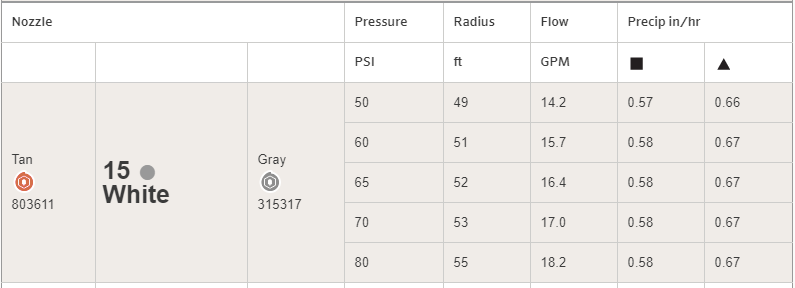Why does rachio 3 default to 1 inch per hour? I asked my irrigation company and he was not sure but estimated 0.33 inches . I’m a newbie to all this but that seems like a large difference. I moved into this house 2 years ago and do not have info on sprinkler heads. It is a hunter sprinkler system likely installed in 1998 when house was built 7 zones 4 rotor heads per zones vast majority are 360 degree or ~180 degree rotation I would estimate 20 foot stream.
We tried to use industry best estimates. .33 inches seems pretty low.
One way to determine is by doing a catch cup test.
https://support.rachio.com/hc/en-us/articles/115010542208-How-do-I-perform-a-catch-cup-test-
This calculator will help derive the results and determine zone efficiency.
i was able to find a part number on the top of my sprinkler heads and look up much more info on it. go take a look
I am new to Rachio as well as to the community. I am trying to figure out some of the parameters after my Rachio controller was installed. I live in Connecticut. I feel that this “Nozzle Inches Per Hour” should be dependent on 4 parameters: 1) how big is the area of the zone, 2) how many sprinkler heads are covering the zone, 3) what is the output of inches/hour for each of the sprinkler head, 4) the size of the area is each sprinkler head measured when measuring the output. Otherwise, there is no way to correctly calibrate the correct amount of time needed to cover the zone. Am I missing something?
I believe the easiest way to get inches per hour is through a catch cup test.
And this has a calculator for your results
https://wateringschedule.com/instructions/

John,
I 100% agree. that makes a ton more sense than the catch cups. I have tried catch cups a few times and sometimes they fall over, and sometimes they are in an odd place etc. I just don’t trust it.
This would be SOOO much better if it was
SQFT:
Number of Sprinkler heads:
GPM/sprinkler head:
Now I am trying to back into the inches per hour by doing the math myself.
Here is an example of the calculation:
Inputs:
SQFT: 2,200
Sprinkler Heads: 6
Gallons per Minute / Head: 1
Calculations:
Total Gallons / Hour= (Sprinkler Heads) * (Gallons per Minute / Head) * (60 Minutes)
6160=360 Gallons
Gallons / Sqft / Hr = (Total Gallons / Hour) / (SQFT)
(360 Gallons / HR) / (2200 SQFT) = .16 Gallons / Sqft / Hr
There are 7.482 Gallons / Cubic Foot.
To calculate Inches / Gallon = 12 inches / 7.482 Gallons
This calculates out to be 1.6042 Inches / Gallon / SQFT
To get to inches / Sqft = (Gallons / Sqft / HR) * (1.6042 Inches / Gallon / SQFT)
(.16 Gallons / Sqft / Hr) * (1.6042 Inches / Gallon / SQFT) = .262 Inches / SQFT / Hr
I created an excel spreadsheet to do this for me. All I have to enter are the inputs listed above and it spits out the Nozzle Inches Per Hour.
Catch cup is by far the best way to get an accurate PR for your yard…period. Just as you said, “in a odd place” no yard is ever perfect, and never do live systems put to the ground what the nozzle manufacturer says (but it is a damn good starting point to use those figures over the default figures). By doing a catch cup test, and finding those “odd places” you can find out how well you are applying the water that the nozzles are putting out.
Otherwise, @johnzhang and @GCanton, you are way overthinking PR. You don’t need to know area being watered. The sprinklers don’t care. They are going to put out the same in/hr PR whether is is 100sq ft or 100sq miles.
Come on, guys. It’s pretty simple. If you have 100sqft of lawn vs 1 acre of lawn, do you think same 3 sprinkler head will give sufficient water for both lawns no matter what the square footages are?
@johnzhang Yes! I think you are confusing precipitation rate (measured in inches per hour) and Gallons per minute.
3 sprinklers in 100sq ft with a PR rate of .60"/hr is going to put down .60"of water in an hours time.
3 sprinklers in 1 acre (if this was actually possible) with a PR rate of .60"/hr is going to put down .60" in an hours time, but use a whole hell of a lot more gallons per minute.
All this is of course assuming similar sprinkler layout, overlap, pressures, etc…
I am sorry I don’t think you are correct here. Instead of soil, think of one small hard plastic box and a gigantic hard plastic box so when water falls into the boxes won’t be absorbed. So each box has the same 3 sprinkler heads which sprinkle out same inch/hr water. At the end of the hour, do you think the depths of accumulated water in the two boxes are the same? Of course not. So the big lawn would have gotten much less water per square foot than the small lawn per square foot.
Same capacity sprinkler heads will put out same amount of water no matter it’s a small lawn or a big lawn. If that water is evenly distributed on a big lawn vs a small lawn, the per square foot big lawn will get a lot less water than per square foot small lawn, so one will need more sprinkler heads to cover bigger areas than small areas. It’s not rocket science.
@johnzhang You are looking at this wrong, trust me…
Let’s look at some BIG golf course rotors. Here is a chart showing the PR of a Hunter TTS-880 with a white nozzle.
Lets assume we have 4 sprinklers, on each corner of a 50x50 square patch of grass, with water pressure set at 60psi. The nozzle is going to put down .58" of water in an hour, and use 852 gallons to do it.
Now, lets assume we have 4 sprinklers, each on a corner of an 85x85 square patch of grass (I know, not as drastic of a difference as you might like), and our pressure is set to 80psi. Look at that! This nozzle is still going to put out .58" of water in an hour, but is going to use 2,616 gallons to do so!
But these are different sprinkler heads with different psi
Yea, and? If you are trying to make the argument using 3 sprinklers covering different areas of ground, you are going to need different nozzles to do so. And those nozzles that throw water further, might very well have the same PR, but use more water in doing so.
I don’t know what to tell you man… PR is PR is PR.
Here is what I was getting at.
I have a number of different size zones. The Nozzle Inches per hour are very different based on the SQFT of the area being watered.
So for an hour of watering in different zones: it is .262, .117, .192 and .083 inches per hour.
tmcgahey, I must not be clear on what I am calculating and talking about. Nozzle Inches Per Hour # would be very different for 100 sq ft or 100sq miles if you are using 3 heads for example. That is what I was talking about and my math calculates. I am going to go remeasure my sqft again, as I was ball parking a bit more to get slightly better #s.
I actually measured the water flow of a number of heads to see what rate was actually dispersing per head.

@tmcgahey and @johnzhang I don’t mean to bring up an old debate between you two, but this really made me think. I initially totally agreed with @johnzhang but then I think it clicked when I thought about this differently. It’s not a measure of quantity (or total gallons) but a rate.
I started to think about this in snow. Two neighbors both experience the same Precipitation rate however one has a driveway twice as large. It doesn’t mean they get half the depth. They both get the same depth. It does change the total Precipitation. However- for an equal area they’d be the same. Maybe this analogy will help others.
Brendan
Well, the total volumes of snow on the two driveways are different, do u agree with that? For the same number of same capacity sprinklers (measured as inch/hr), the covering surface areas will clearly matter. A simple extreme example would be: 1 sprinkler head will give too much water in an hour for a one square foot area, but not enough for a one square mile lawn.
But, you wouldn’t be using the same sprinkler/nozzle in each of those applications. With 1 square miles of lawn, you would be using a nozzles that is capable of much larger GPM, and might still have the same PR (inches/hour) as a nozzle in a much smaller area.
Again you are missing the point. At home, we usually have the irrigation system in place, we are only changing the control system. Let’s say we have three sprinkler heads for a set plot of lawn. We want to calculate how much time we need to run these three sprinkler heads to provide sufficient water to this specific plot of lawn. Without knowing the square footage of this plot of lawn (it could be 100 square feet or 1000 square feet), the measure of inch/hour is useless…
I am not missing any point. Yes, area is needed to measure of PR, but every nozzle manufacturer under the sun gives you that value based on the area (radius) the nozzle covers, and even factors in sprinkler overlap and pressure.


